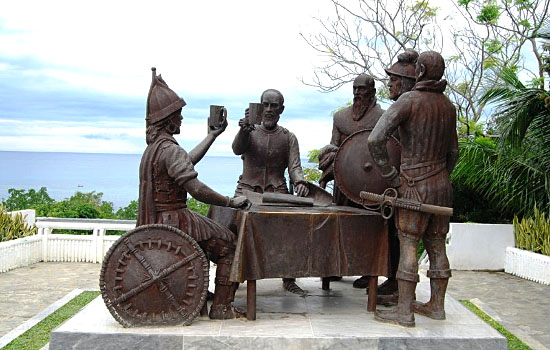
The Blood Compact Shrine in Bohol, Philippines, also known as the Sandugo Shrine, is a significant historical landmark commemorating the first treaty of friendship between Filipinos and Spaniards. This monument marks the site where the blood compact (sandugo) was performed between the local chieftain Datu Sikatuna and the Spanish explorer Miguel López de Legazpi in 1565.
Key Features and Attractions:
- Historical Significance:
- The blood compact, or sandugo, is a traditional Filipino ritual symbolizing a treaty of friendship and alliance. It involved the participants cutting their wrists and mixing their blood with wine, which they then drank.
- This particular blood compact marked the first formal treaty of friendship between the Philippines and Spain, paving the way for Spanish colonization and the spread of Christianity in the archipelago.
- Monument Design:
- The shrine features a bronze sculpture created by the renowned Filipino artist, Napoleon Abueva, who is also a native of Bohol.
- The sculpture depicts the historic event, with life-sized figures of Datu Sikatuna, Miguel López de Legazpi, and other participants seated around a table, performing the blood compact ritual.
- The monument is set on a raised platform, providing a dramatic and respectful setting for the depiction of this significant event.
- Scenic Location:
- The shrine is located in Barangay Bool, Tagbilaran City, Bohol. It is situated on a scenic coastal area, offering visitors stunning views of the Bohol Sea.
- The picturesque surroundings add to the charm of the site, making it a pleasant spot for reflection and photography.
- Cultural and Educational Value:
- The Blood Compact Shrine serves as an educational site, providing insights into the early interactions between Filipinos and Spaniards and the historical context of the colonial period in the Philippines.
- Visitors can learn about the significance of the blood compact ritual in Filipino culture and its impact on the history of the Philippines.
Visitor Information:
- Location: Barangay Bool, Tagbilaran City, Bohol, Philippines
- Opening Hours: The shrine is open to the public daily, and visitors can visit at any time as it is an open-air monument.
- Entrance Fee: There is no entrance fee to visit the shrine, making it accessible to all visitors.
Tips for Visitors:
- Best Time to Visit:
- The shrine can be visited year-round, but the best time to visit is during the dry season, from November to May, for more favorable weather conditions.
- Early morning or late afternoon visits are ideal for avoiding the midday heat and for capturing the best lighting for photography.
- Photography:
- The monument and its scenic coastal backdrop provide excellent opportunities for photography. Be sure to capture the intricate details of the sculpture and the beautiful surrounding landscape.
- Respectful Behavior:
- As a site of historical and cultural significance, visitors are encouraged to behave respectfully. Avoid climbing on the monument or engaging in any activities that could damage the sculpture.
- Combine with Other Attractions:
- The Blood Compact Shrine is located near other attractions in Tagbilaran City, such as the Baclayon Church and the Bohol National Museum. Plan your visit to include multiple sites for a comprehensive tour of Bohol’s historical landmarks.
The Blood Compact Shrine in Bohol is not only a significant historical monument but also a symbol of friendship and cultural heritage. It provides a meaningful glimpse into the early history of the Philippines and its interactions with the Spanish explorers, making it a must-visit destination for history enthusiasts and travelers.
